Enable College - CHCDIS001: Contribute to Ongoing Skills Assessment
VerifiedAdded on 2023/02/01
|35
|5197
|74
Homework Assignment
AI Summary
This assignment is a comprehensive assessment for the CHCDIS001 unit, focusing on contributing to ongoing skills development using a strengths-based approach. It covers a wide range of topics including duty of care, interdependence, and person-centered care. The assessment explores the roles of various stakeholders in the assessment process, objective observation techniques, and methods for providing positive feedback. It delves into the creation and implementation of skill development plans, the importance of active support, and the application of strength-based practices. The assignment also examines the value of tools like RAMP, SWOT analysis, and resource plans. Furthermore, it addresses different reinforcement techniques, the importance of client self-assessment, and strategies for handling uncooperative clients. The assessment includes detailed explanations of formal, informal, and incidental learning, as well as practical examples of modelling, shaping, prompting, chaining, and fading. The assignment also requires the analysis of social valorization and its impact on a person's quality of life, along with a case study analysis to apply the concepts learned.
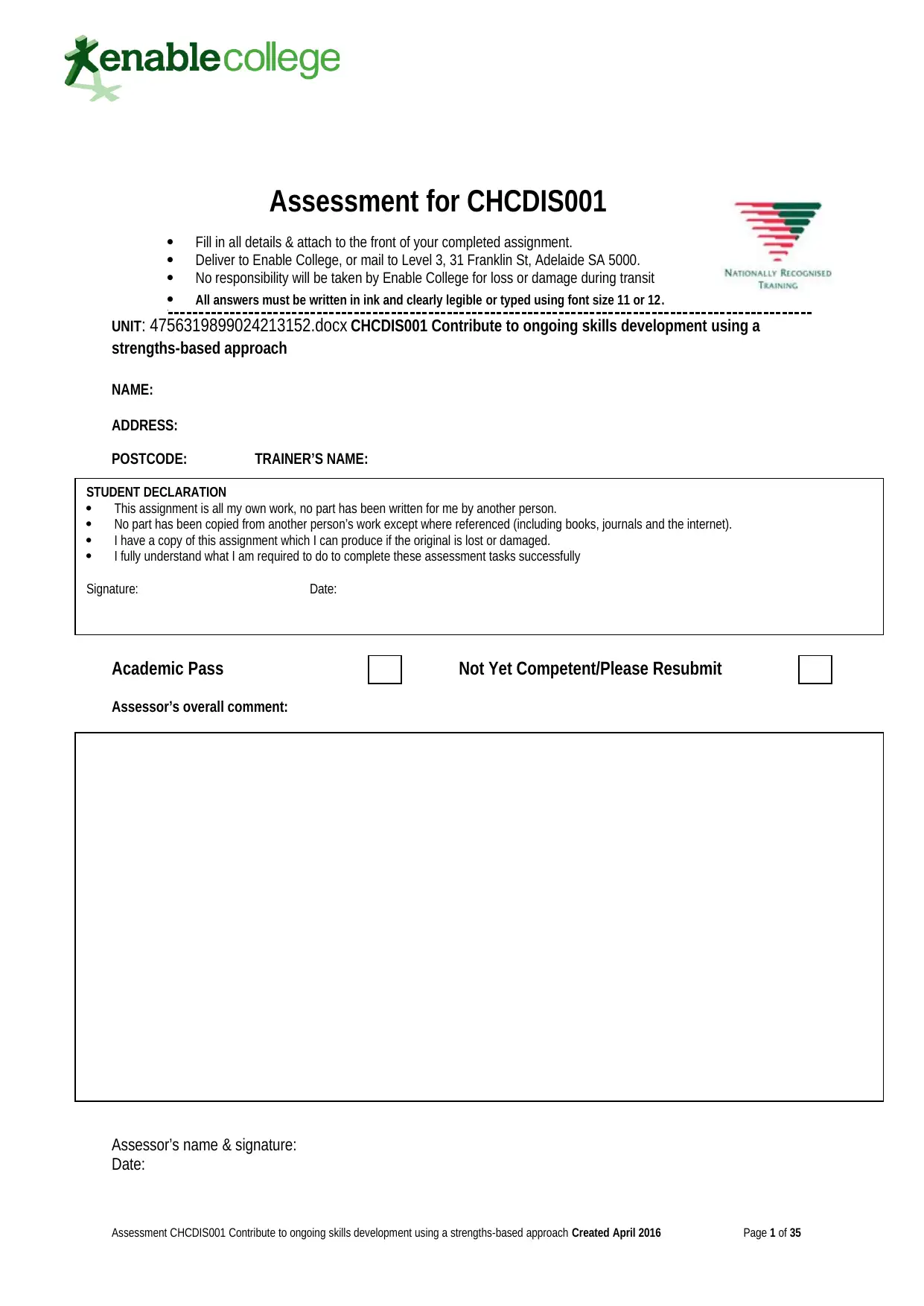
Assessment for CHCDIS001
Fill in all details & attach to the front of your completed assignment.
Deliver to Enable College, or mail to Level 3, 31 Franklin St, Adelaide SA 5000.
No responsibility will be taken by Enable College for loss or damage during transit
All answers must be written in ink and clearly legible or typed using font size 11 or 12.
UNIT: 4756319899024213152.docx CHCDIS001 Contribute to ongoing skills development using a
strengths-based approach
NAME:
ADDRESS:
POSTCODE: TRAINER’S NAME:
Academic Pass Not Yet Competent/Please Resubmit
Assessor’s overall comment:
Assessor’s name & signature:
Date:
Assessment CHCDIS001 Contribute to ongoing skills development using a strengths-based approach Created April 2016 Page 1 of 35
STUDENT DECLARATION
This assignment is all my own work, no part has been written for me by another person.
No part has been copied from another person’s work except where referenced (including books, journals and the internet).
I have a copy of this assignment which I can produce if the original is lost or damaged.
I fully understand what I am required to do to complete these assessment tasks successfully
Signature: Date:
Fill in all details & attach to the front of your completed assignment.
Deliver to Enable College, or mail to Level 3, 31 Franklin St, Adelaide SA 5000.
No responsibility will be taken by Enable College for loss or damage during transit
All answers must be written in ink and clearly legible or typed using font size 11 or 12.
UNIT: 4756319899024213152.docx CHCDIS001 Contribute to ongoing skills development using a
strengths-based approach
NAME:
ADDRESS:
POSTCODE: TRAINER’S NAME:
Academic Pass Not Yet Competent/Please Resubmit
Assessor’s overall comment:
Assessor’s name & signature:
Date:
Assessment CHCDIS001 Contribute to ongoing skills development using a strengths-based approach Created April 2016 Page 1 of 35
STUDENT DECLARATION
This assignment is all my own work, no part has been written for me by another person.
No part has been copied from another person’s work except where referenced (including books, journals and the internet).
I have a copy of this assignment which I can produce if the original is lost or damaged.
I fully understand what I am required to do to complete these assessment tasks successfully
Signature: Date:
Paraphrase This Document
Need a fresh take? Get an instant paraphrase of this document with our AI Paraphraser
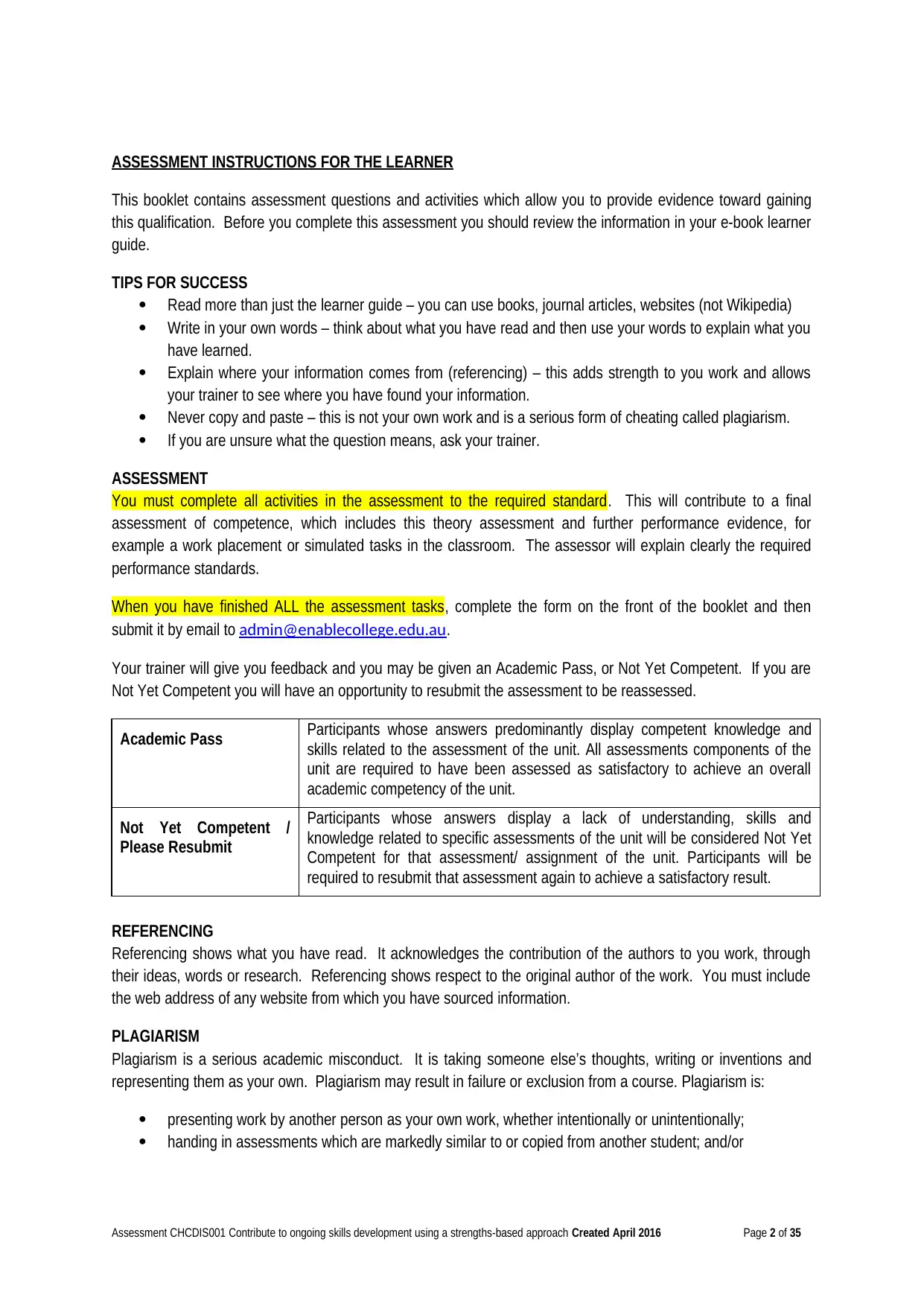
ASSESSMENT INSTRUCTIONS FOR THE LEARNER
This booklet contains assessment questions and activities which allow you to provide evidence toward gaining
this qualification. Before you complete this assessment you should review the information in your e-book learner
guide.
TIPS FOR SUCCESS
Read more than just the learner guide – you can use books, journal articles, websites (not Wikipedia)
Write in your own words – think about what you have read and then use your words to explain what you
have learned.
Explain where your information comes from (referencing) – this adds strength to you work and allows
your trainer to see where you have found your information.
Never copy and paste – this is not your own work and is a serious form of cheating called plagiarism.
If you are unsure what the question means, ask your trainer.
ASSESSMENT
You must complete all activities in the assessment to the required standard. This will contribute to a final
assessment of competence, which includes this theory assessment and further performance evidence, for
example a work placement or simulated tasks in the classroom. The assessor will explain clearly the required
performance standards.
When you have finished ALL the assessment tasks, complete the form on the front of the booklet and then
submit it by email to admin@enablecollege.edu.au.
Your trainer will give you feedback and you may be given an Academic Pass, or Not Yet Competent. If you are
Not Yet Competent you will have an opportunity to resubmit the assessment to be reassessed.
Academic Pass Participants whose answers predominantly display competent knowledge and
skills related to the assessment of the unit. All assessments components of the
unit are required to have been assessed as satisfactory to achieve an overall
academic competency of the unit.
Not Yet Competent /
Please Resubmit
Participants whose answers display a lack of understanding, skills and
knowledge related to specific assessments of the unit will be considered Not Yet
Competent for that assessment/ assignment of the unit. Participants will be
required to resubmit that assessment again to achieve a satisfactory result.
REFERENCING
Referencing shows what you have read. It acknowledges the contribution of the authors to you work, through
their ideas, words or research. Referencing shows respect to the original author of the work. You must include
the web address of any website from which you have sourced information.
PLAGIARISM
Plagiarism is a serious academic misconduct. It is taking someone else’s thoughts, writing or inventions and
representing them as your own. Plagiarism may result in failure or exclusion from a course. Plagiarism is:
presenting work by another person as your own work, whether intentionally or unintentionally;
handing in assessments which are markedly similar to or copied from another student; and/or
Assessment CHCDIS001 Contribute to ongoing skills development using a strengths-based approach Created April 2016 Page 2 of 35
This booklet contains assessment questions and activities which allow you to provide evidence toward gaining
this qualification. Before you complete this assessment you should review the information in your e-book learner
guide.
TIPS FOR SUCCESS
Read more than just the learner guide – you can use books, journal articles, websites (not Wikipedia)
Write in your own words – think about what you have read and then use your words to explain what you
have learned.
Explain where your information comes from (referencing) – this adds strength to you work and allows
your trainer to see where you have found your information.
Never copy and paste – this is not your own work and is a serious form of cheating called plagiarism.
If you are unsure what the question means, ask your trainer.
ASSESSMENT
You must complete all activities in the assessment to the required standard. This will contribute to a final
assessment of competence, which includes this theory assessment and further performance evidence, for
example a work placement or simulated tasks in the classroom. The assessor will explain clearly the required
performance standards.
When you have finished ALL the assessment tasks, complete the form on the front of the booklet and then
submit it by email to admin@enablecollege.edu.au.
Your trainer will give you feedback and you may be given an Academic Pass, or Not Yet Competent. If you are
Not Yet Competent you will have an opportunity to resubmit the assessment to be reassessed.
Academic Pass Participants whose answers predominantly display competent knowledge and
skills related to the assessment of the unit. All assessments components of the
unit are required to have been assessed as satisfactory to achieve an overall
academic competency of the unit.
Not Yet Competent /
Please Resubmit
Participants whose answers display a lack of understanding, skills and
knowledge related to specific assessments of the unit will be considered Not Yet
Competent for that assessment/ assignment of the unit. Participants will be
required to resubmit that assessment again to achieve a satisfactory result.
REFERENCING
Referencing shows what you have read. It acknowledges the contribution of the authors to you work, through
their ideas, words or research. Referencing shows respect to the original author of the work. You must include
the web address of any website from which you have sourced information.
PLAGIARISM
Plagiarism is a serious academic misconduct. It is taking someone else’s thoughts, writing or inventions and
representing them as your own. Plagiarism may result in failure or exclusion from a course. Plagiarism is:
presenting work by another person as your own work, whether intentionally or unintentionally;
handing in assessments which are markedly similar to or copied from another student; and/or
Assessment CHCDIS001 Contribute to ongoing skills development using a strengths-based approach Created April 2016 Page 2 of 35

submitting assessments without adequate acknowledgement of the sources used i.e. without
referencing.
Assessment CHCDIS001 Contribute to ongoing skills development using a strengths-based approach Created April 2016 Page 3 of 35
referencing.
Assessment CHCDIS001 Contribute to ongoing skills development using a strengths-based approach Created April 2016 Page 3 of 35
⊘ This is a preview!⊘
Do you want full access?
Subscribe today to unlock all pages.

Trusted by 1+ million students worldwide
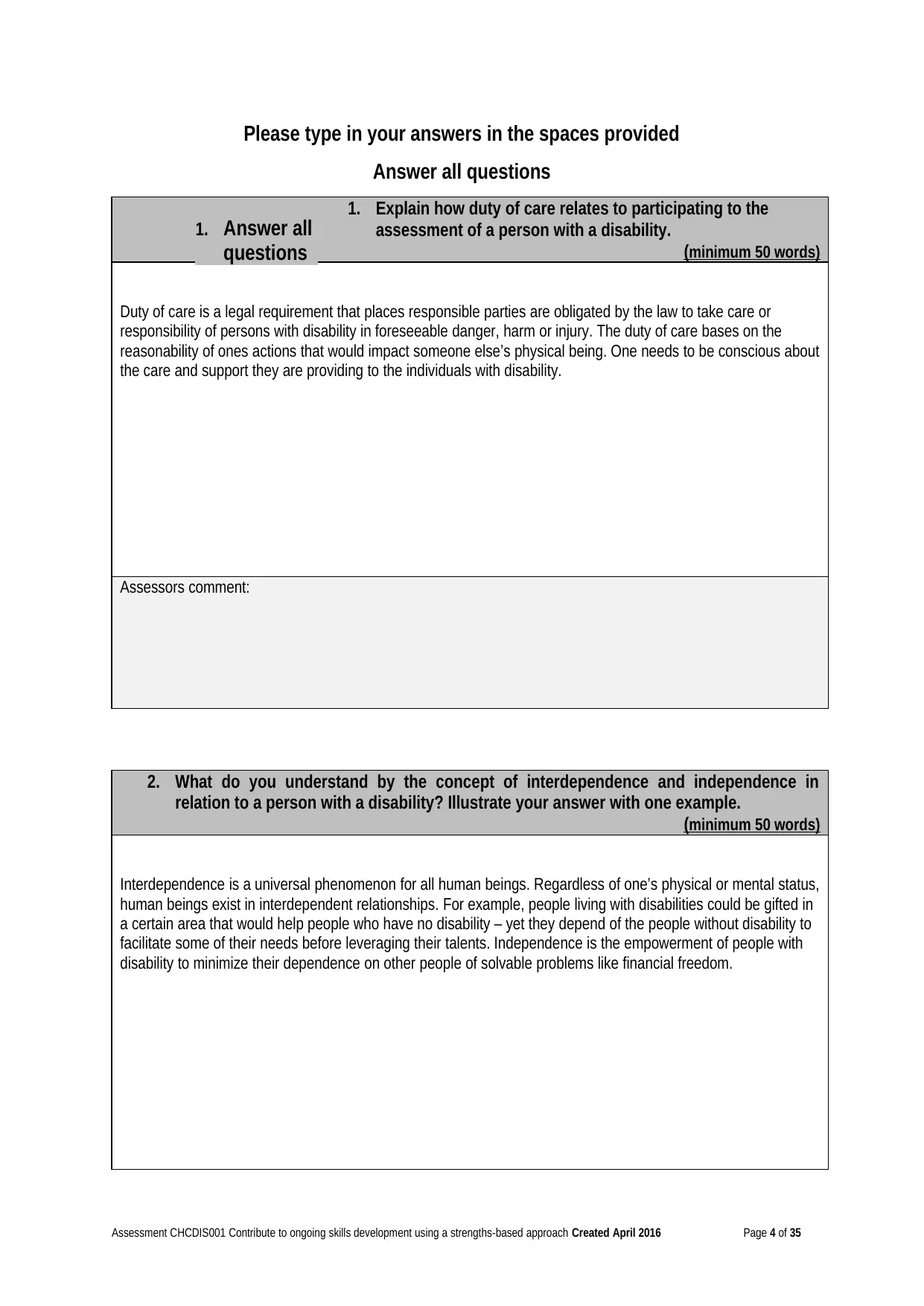
Please type in your answers in the spaces provided
Answer all questions
1. Explain how duty of care relates to participating to the
assessment of a person with a disability.
(minimum 50 words)
Duty of care is a legal requirement that places responsible parties are obligated by the law to take care or
responsibility of persons with disability in foreseeable danger, harm or injury. The duty of care bases on the
reasonability of ones actions that would impact someone else’s physical being. One needs to be conscious about
the care and support they are providing to the individuals with disability.
Assessors comment:
2. What do you understand by the concept of interdependence and independence in
relation to a person with a disability? Illustrate your answer with one example.
(minimum 50 words)
Interdependence is a universal phenomenon for all human beings. Regardless of one’s physical or mental status,
human beings exist in interdependent relationships. For example, people living with disabilities could be gifted in
a certain area that would help people who have no disability – yet they depend of the people without disability to
facilitate some of their needs before leveraging their talents. Independence is the empowerment of people with
disability to minimize their dependence on other people of solvable problems like financial freedom.
Assessment CHCDIS001 Contribute to ongoing skills development using a strengths-based approach Created April 2016 Page 4 of 35
1. Answer all
questions
Answer all questions
1. Explain how duty of care relates to participating to the
assessment of a person with a disability.
(minimum 50 words)
Duty of care is a legal requirement that places responsible parties are obligated by the law to take care or
responsibility of persons with disability in foreseeable danger, harm or injury. The duty of care bases on the
reasonability of ones actions that would impact someone else’s physical being. One needs to be conscious about
the care and support they are providing to the individuals with disability.
Assessors comment:
2. What do you understand by the concept of interdependence and independence in
relation to a person with a disability? Illustrate your answer with one example.
(minimum 50 words)
Interdependence is a universal phenomenon for all human beings. Regardless of one’s physical or mental status,
human beings exist in interdependent relationships. For example, people living with disabilities could be gifted in
a certain area that would help people who have no disability – yet they depend of the people without disability to
facilitate some of their needs before leveraging their talents. Independence is the empowerment of people with
disability to minimize their dependence on other people of solvable problems like financial freedom.
Assessment CHCDIS001 Contribute to ongoing skills development using a strengths-based approach Created April 2016 Page 4 of 35
1. Answer all
questions
Paraphrase This Document
Need a fresh take? Get an instant paraphrase of this document with our AI Paraphraser
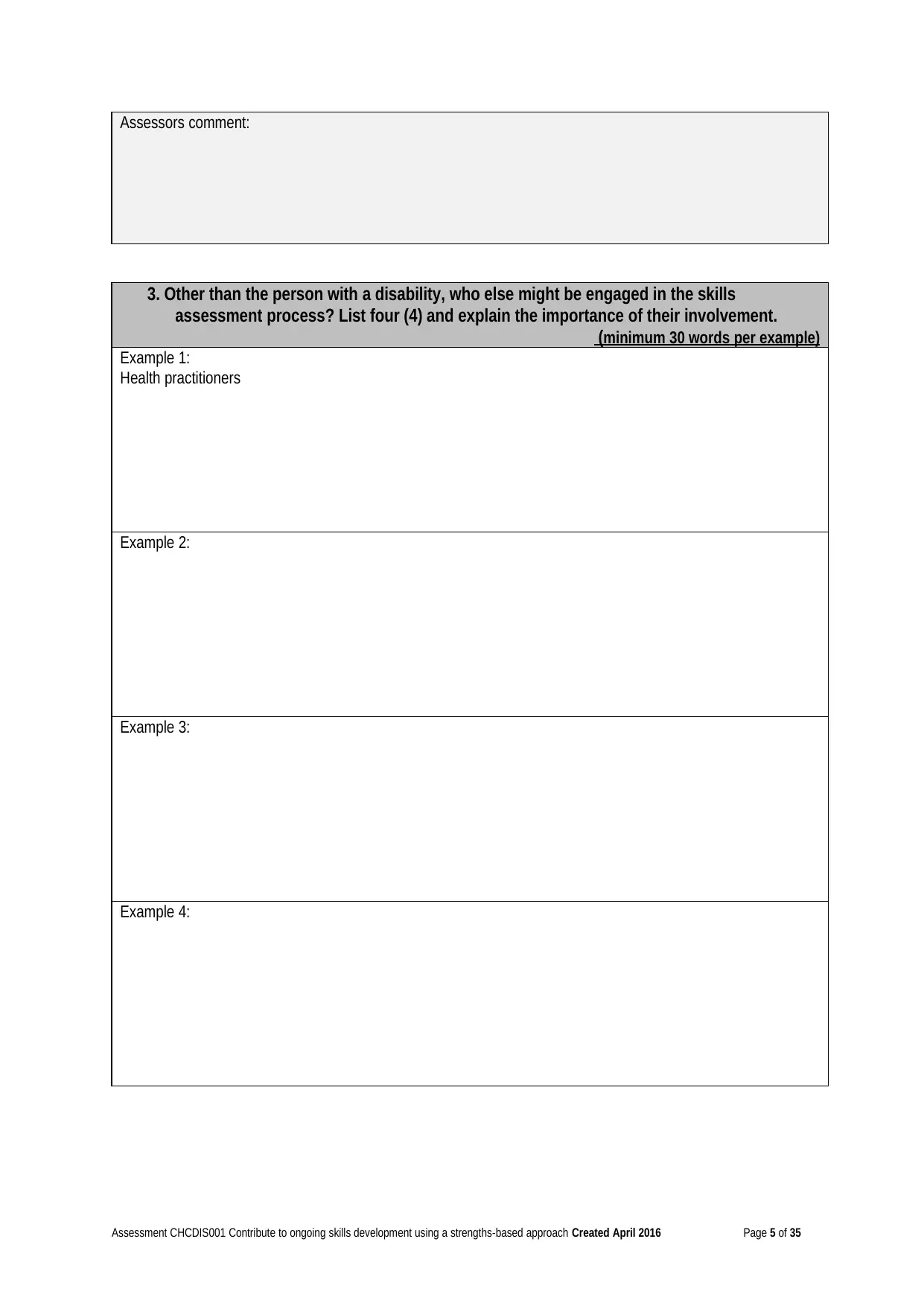
Assessors comment:
3. Other than the person with a disability, who else might be engaged in the skills
assessment process? List four (4) and explain the importance of their involvement.
(minimum 30 words per example)
Example 1:
Health practitioners
Example 2:
Example 3:
Example 4:
Assessment CHCDIS001 Contribute to ongoing skills development using a strengths-based approach Created April 2016 Page 5 of 35
3. Other than the person with a disability, who else might be engaged in the skills
assessment process? List four (4) and explain the importance of their involvement.
(minimum 30 words per example)
Example 1:
Health practitioners
Example 2:
Example 3:
Example 4:
Assessment CHCDIS001 Contribute to ongoing skills development using a strengths-based approach Created April 2016 Page 5 of 35

Assessors comment:
Assessment CHCDIS001 Contribute to ongoing skills development using a strengths-based approach Created April 2016 Page 6 of 35
Assessment CHCDIS001 Contribute to ongoing skills development using a strengths-based approach Created April 2016 Page 6 of 35
⊘ This is a preview!⊘
Do you want full access?
Subscribe today to unlock all pages.

Trusted by 1+ million students worldwide
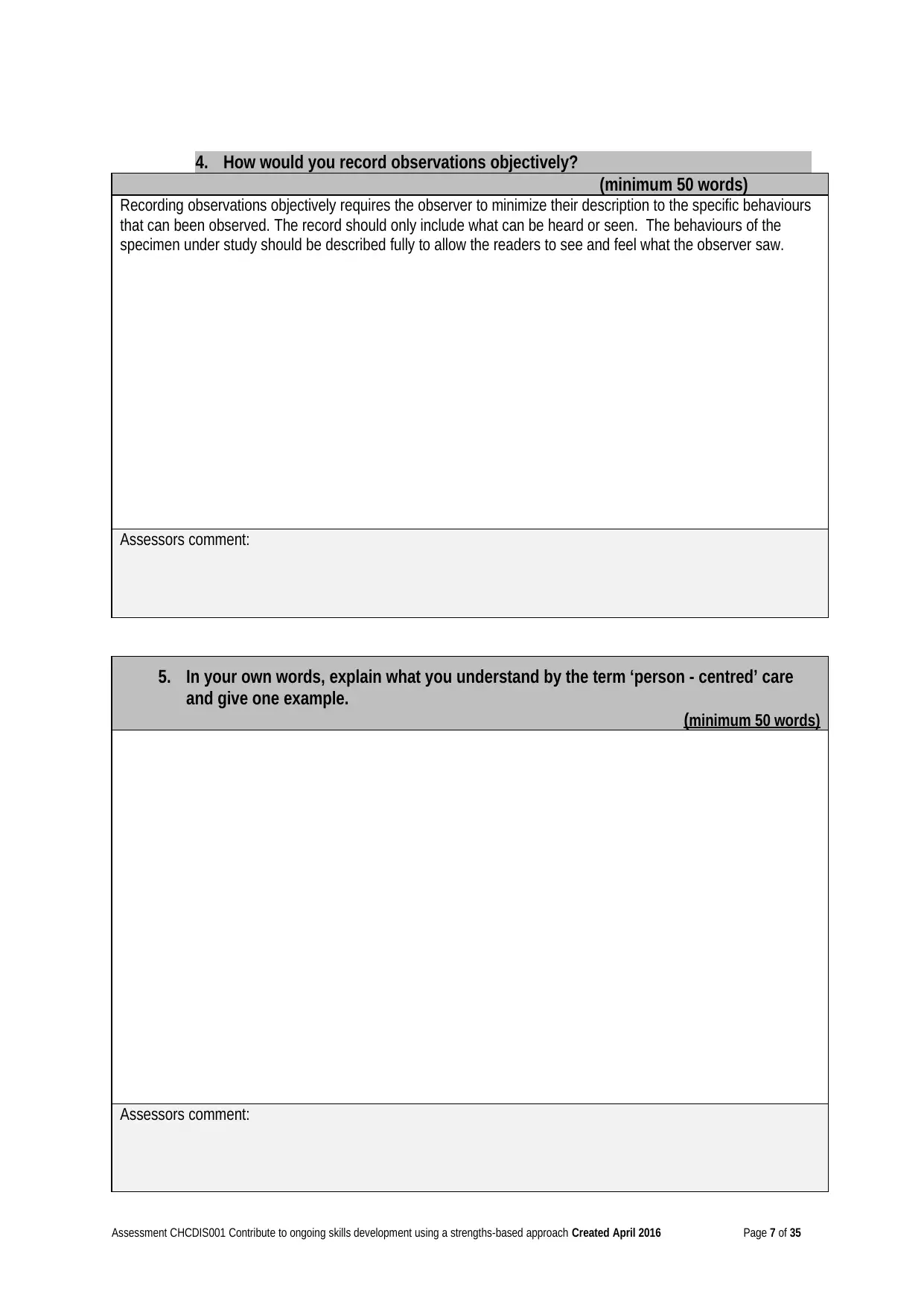
4. How would you record observations objectively?
(minimum 50 words)
Recording observations objectively requires the observer to minimize their description to the specific behaviours
that can been observed. The record should only include what can be heard or seen. The behaviours of the
specimen under study should be described fully to allow the readers to see and feel what the observer saw.
Assessors comment:
5. In your own words, explain what you understand by the term ‘person - centred’ care
and give one example.
(minimum 50 words)
Assessors comment:
Assessment CHCDIS001 Contribute to ongoing skills development using a strengths-based approach Created April 2016 Page 7 of 35
(minimum 50 words)
Recording observations objectively requires the observer to minimize their description to the specific behaviours
that can been observed. The record should only include what can be heard or seen. The behaviours of the
specimen under study should be described fully to allow the readers to see and feel what the observer saw.
Assessors comment:
5. In your own words, explain what you understand by the term ‘person - centred’ care
and give one example.
(minimum 50 words)
Assessors comment:
Assessment CHCDIS001 Contribute to ongoing skills development using a strengths-based approach Created April 2016 Page 7 of 35
Paraphrase This Document
Need a fresh take? Get an instant paraphrase of this document with our AI Paraphraser
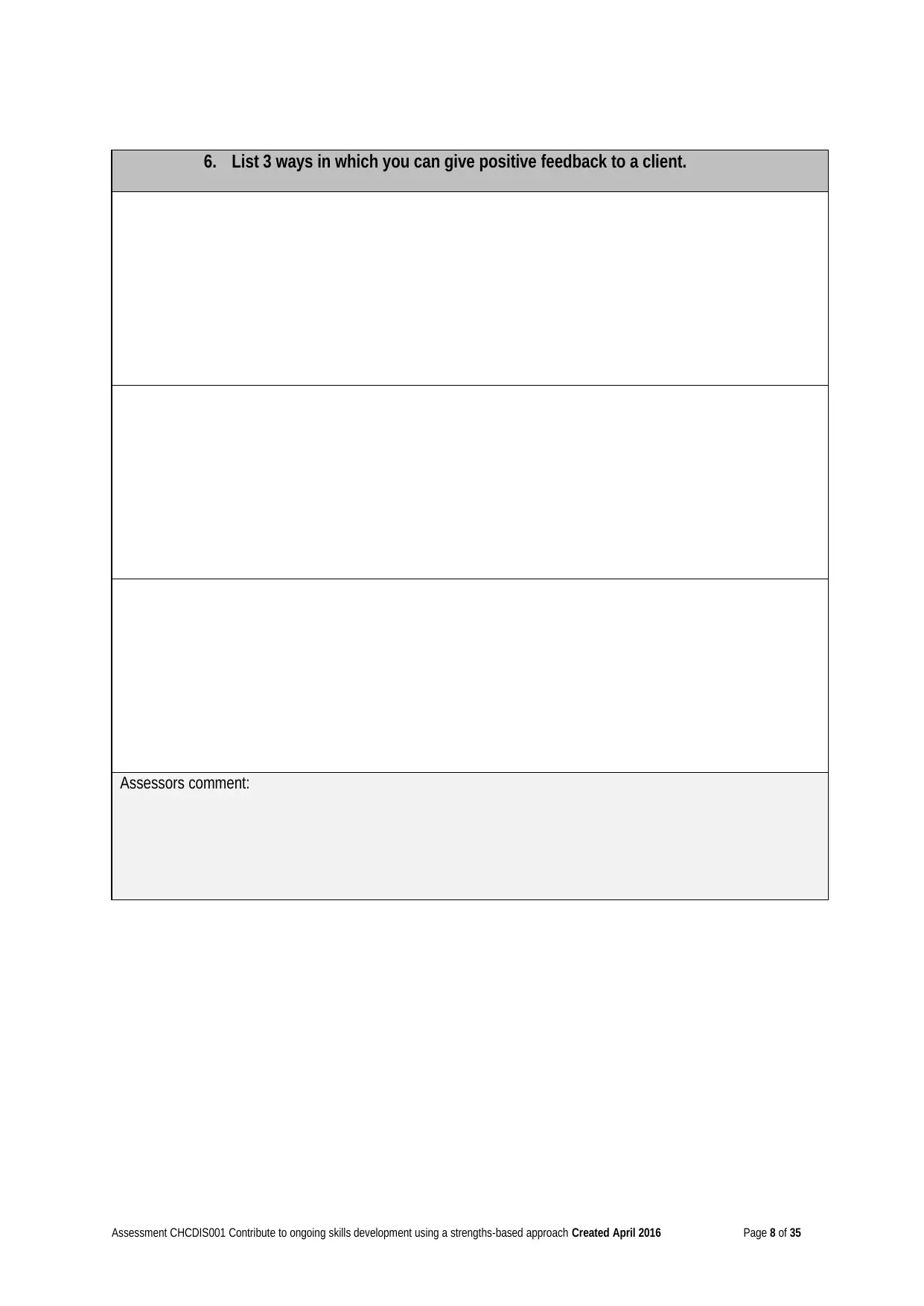
6. List 3 ways in which you can give positive feedback to a client.
Assessors comment:
Assessment CHCDIS001 Contribute to ongoing skills development using a strengths-based approach Created April 2016 Page 8 of 35
Assessors comment:
Assessment CHCDIS001 Contribute to ongoing skills development using a strengths-based approach Created April 2016 Page 8 of 35
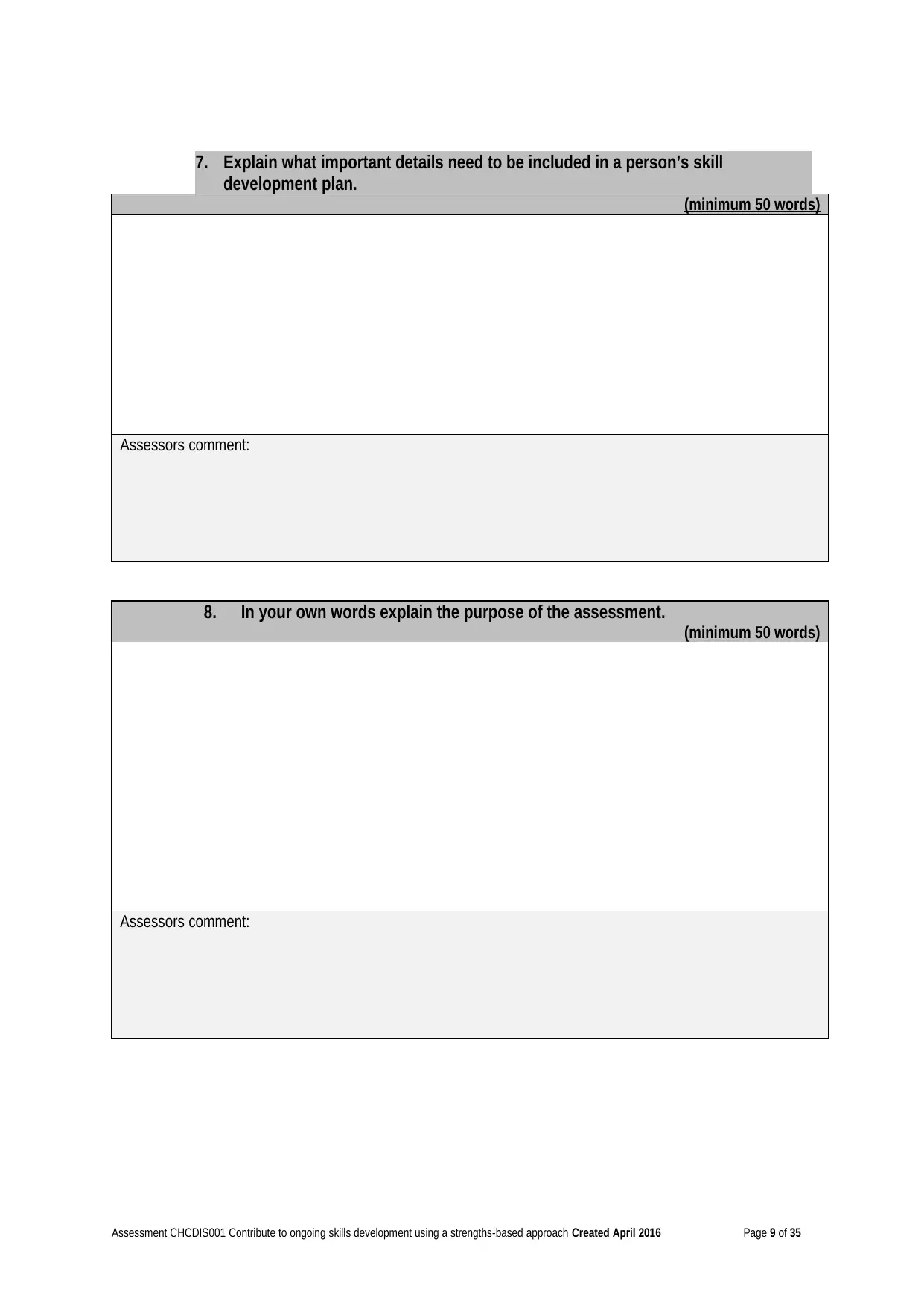
7. Explain what important details need to be included in a person’s skill
development plan.
(minimum 50 words)
Assessors comment:
8. In your own words explain the purpose of the assessment.
(minimum 50 words)
Assessors comment:
Assessment CHCDIS001 Contribute to ongoing skills development using a strengths-based approach Created April 2016 Page 9 of 35
development plan.
(minimum 50 words)
Assessors comment:
8. In your own words explain the purpose of the assessment.
(minimum 50 words)
Assessors comment:
Assessment CHCDIS001 Contribute to ongoing skills development using a strengths-based approach Created April 2016 Page 9 of 35
⊘ This is a preview!⊘
Do you want full access?
Subscribe today to unlock all pages.

Trusted by 1+ million students worldwide
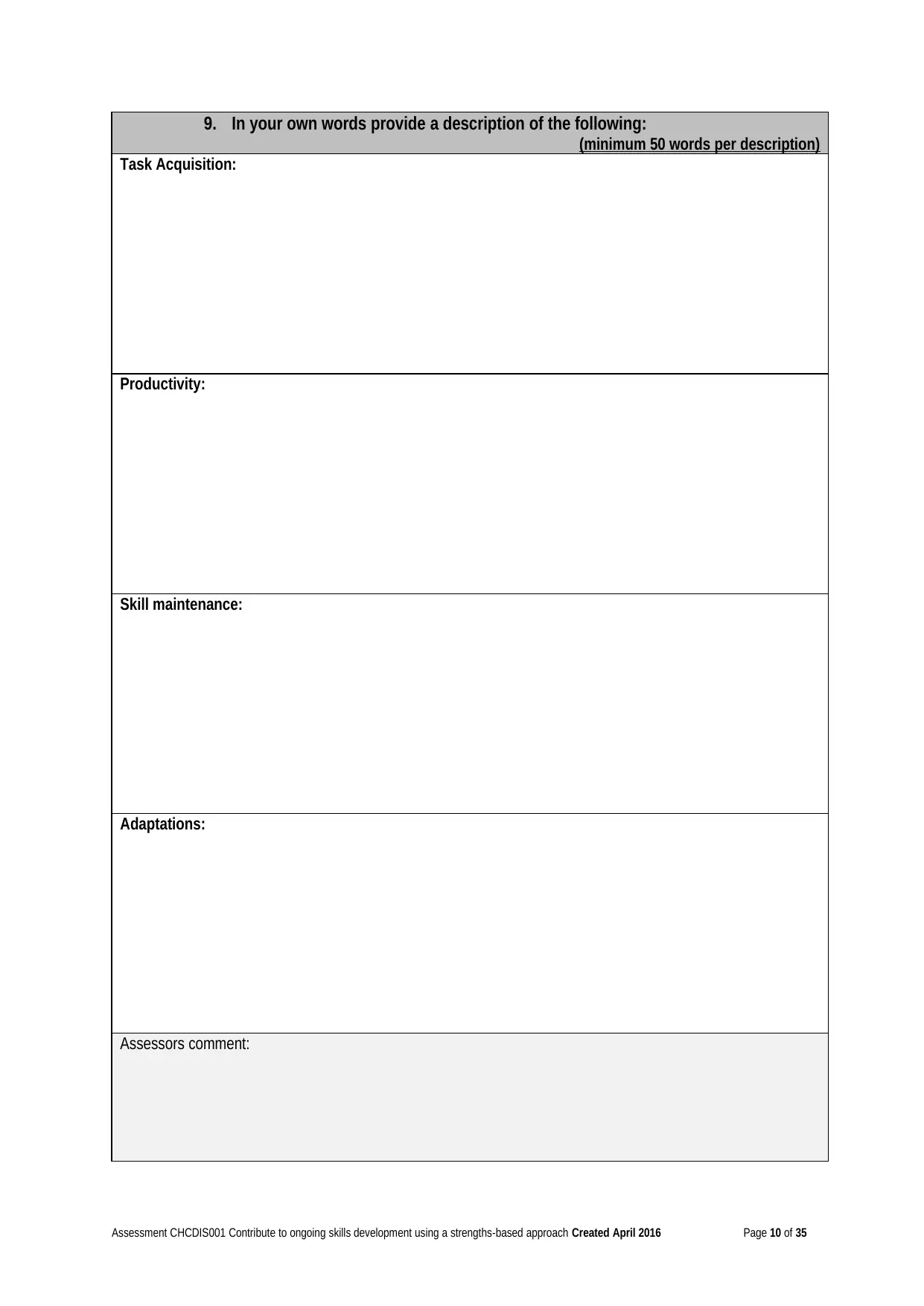
9. In your own words provide a description of the following:
(minimum 50 words per description)
Task Acquisition:
Productivity:
Skill maintenance:
Adaptations:
Assessors comment:
Assessment CHCDIS001 Contribute to ongoing skills development using a strengths-based approach Created April 2016 Page 10 of 35
(minimum 50 words per description)
Task Acquisition:
Productivity:
Skill maintenance:
Adaptations:
Assessors comment:
Assessment CHCDIS001 Contribute to ongoing skills development using a strengths-based approach Created April 2016 Page 10 of 35
Paraphrase This Document
Need a fresh take? Get an instant paraphrase of this document with our AI Paraphraser
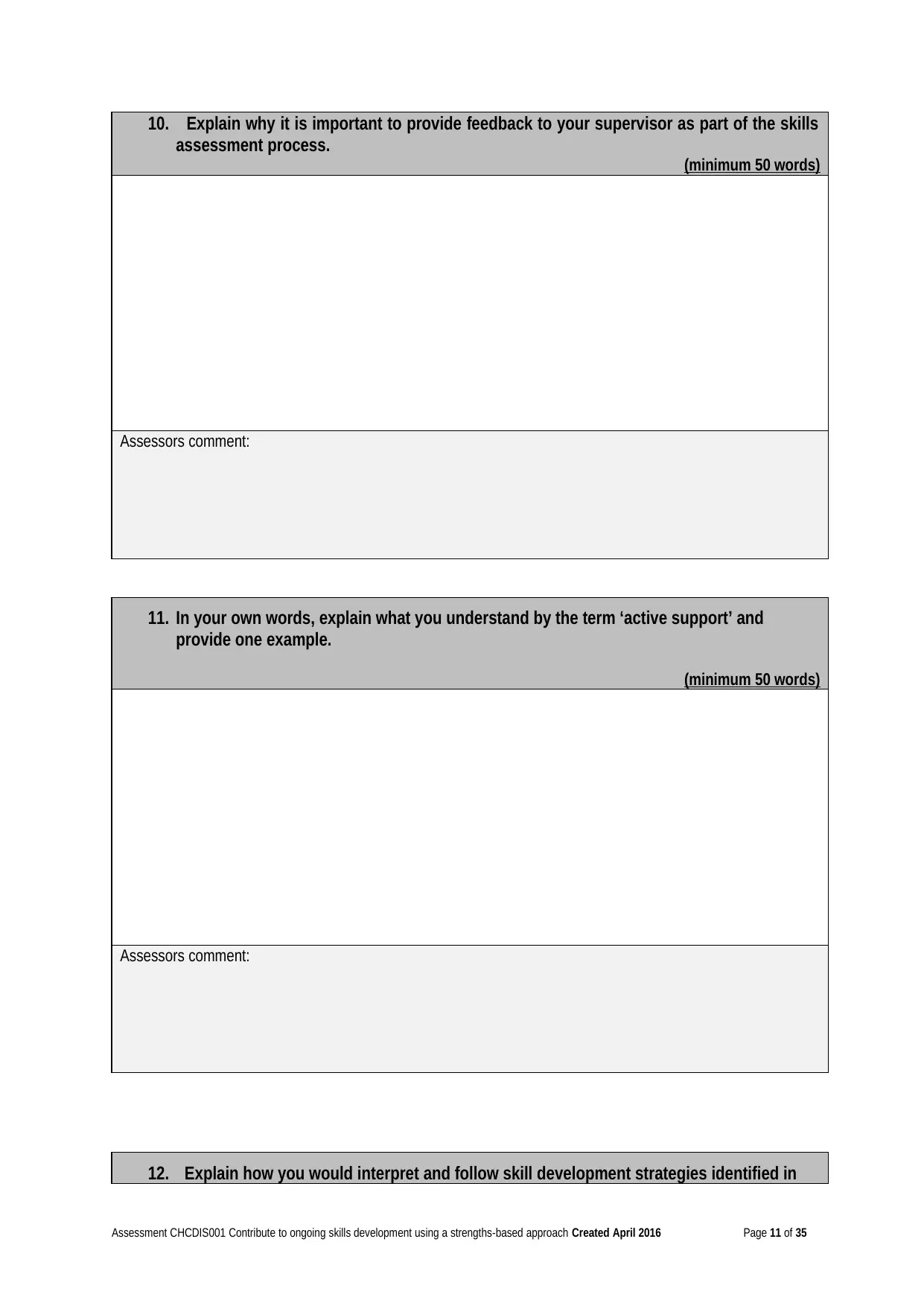
10. Explain why it is important to provide feedback to your supervisor as part of the skills
assessment process.
(minimum 50 words)
Assessors comment:
11. In your own words, explain what you understand by the term ‘active support’ and
provide one example.
(minimum 50 words)
Assessors comment:
12. Explain how you would interpret and follow skill development strategies identified in
Assessment CHCDIS001 Contribute to ongoing skills development using a strengths-based approach Created April 2016 Page 11 of 35
assessment process.
(minimum 50 words)
Assessors comment:
11. In your own words, explain what you understand by the term ‘active support’ and
provide one example.
(minimum 50 words)
Assessors comment:
12. Explain how you would interpret and follow skill development strategies identified in
Assessment CHCDIS001 Contribute to ongoing skills development using a strengths-based approach Created April 2016 Page 11 of 35
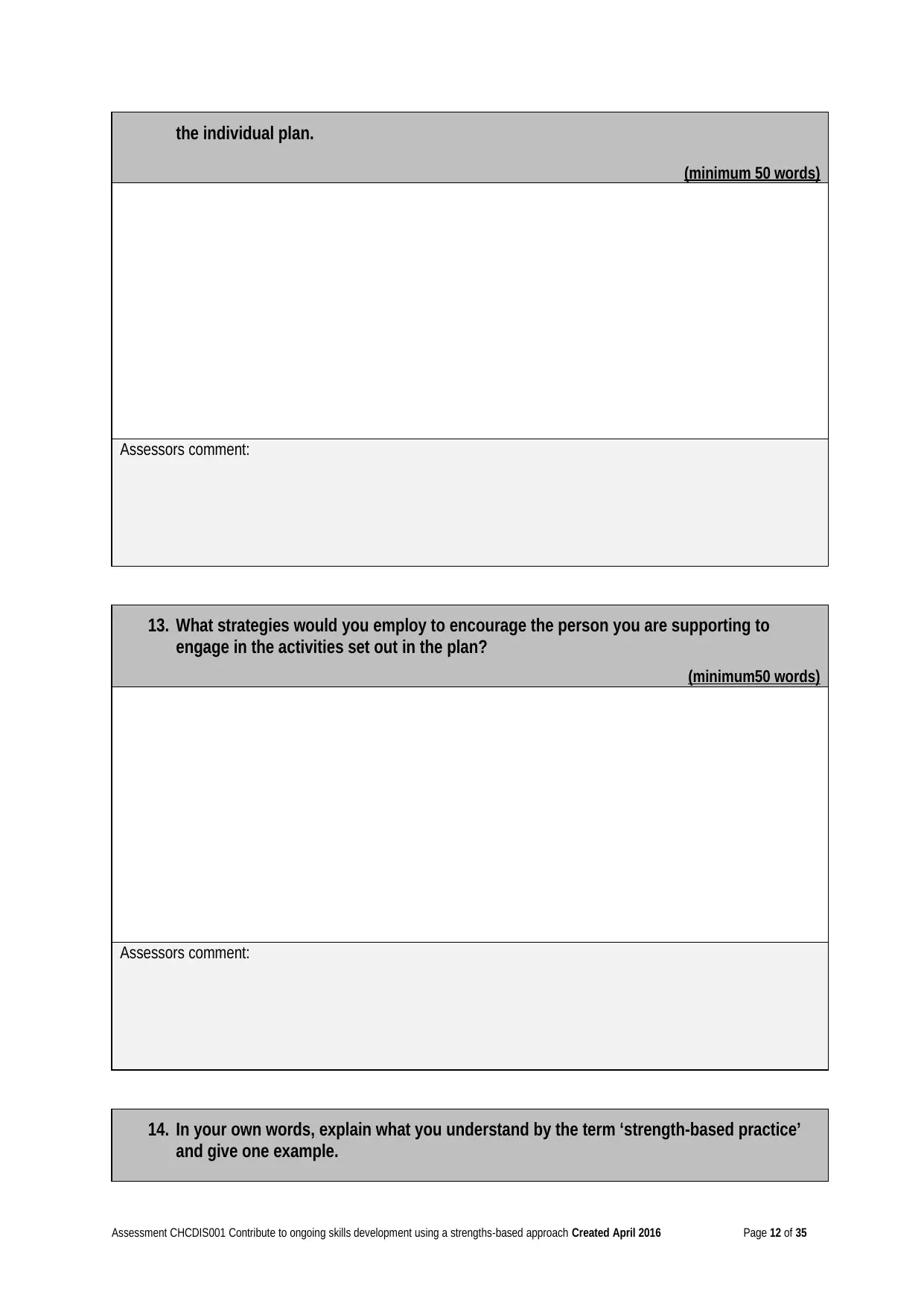
the individual plan.
(minimum 50 words)
Assessors comment:
13. What strategies would you employ to encourage the person you are supporting to
engage in the activities set out in the plan?
(minimum50 words)
Assessors comment:
14. In your own words, explain what you understand by the term ‘strength-based practice’
and give one example.
Assessment CHCDIS001 Contribute to ongoing skills development using a strengths-based approach Created April 2016 Page 12 of 35
(minimum 50 words)
Assessors comment:
13. What strategies would you employ to encourage the person you are supporting to
engage in the activities set out in the plan?
(minimum50 words)
Assessors comment:
14. In your own words, explain what you understand by the term ‘strength-based practice’
and give one example.
Assessment CHCDIS001 Contribute to ongoing skills development using a strengths-based approach Created April 2016 Page 12 of 35
⊘ This is a preview!⊘
Do you want full access?
Subscribe today to unlock all pages.

Trusted by 1+ million students worldwide
1 out of 35
Related Documents
Your All-in-One AI-Powered Toolkit for Academic Success.
+13062052269
info@desklib.com
Available 24*7 on WhatsApp / Email
![[object Object]](/_next/static/media/star-bottom.7253800d.svg)
Unlock your academic potential
Copyright © 2020–2025 A2Z Services. All Rights Reserved. Developed and managed by ZUCOL.





